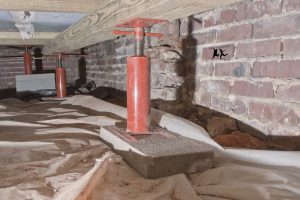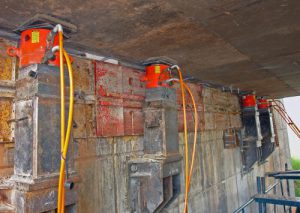A jack is a versatile tool that uses force to lift heavy loads. Screw threads and hydraulic cylinders are the primary mechanisms with which force is applied; therefore, jacks fall under the categories of mechanical or hydraulic.

Mechanical jacks, such as car jacks and house jacks, hoist heavy equipment and are rated on lift capacity. Hydraulic jacks, on the other hand, tend to be stronger and can hoist heavier loads higher. These types include bottle jacks and floor jacks.
Both mechanical and hydraulic jacks are used in countless industries, including the automotive, shipping, mining, waste removal, and retail sectors. Jacks are also commonly utilized in construction applications to lift heavy equipment and support or lift a building during renovation or relocation.
Mechanical Jacks in Construction
Often found in automotive garages, mechanical jacks use physical means to raise and lower loads, which typically range from 1.5 tons to 3 tons. A screw jack is a common type of mechanical jack, which works via a motor or lever cranked by an operator. A screw uses the shape of its threads to raise or lower the load, or a traveling nut does the lifting while the screw turns in place. Mechanical jacks are self-locking, which means that when power is removed from the jack, the screw stays in place until power resumes. This setup makes mechanical jacks safer than their hydraulic counterparts, because users don’t have to fear a loss of power.
Mechanical jacks are used to change stage designs, alter settings on woodworking machines, and adjust radio telescopes. In the construction industry, screw jacks — also called house jacks — are used to hoist buildings from their foundations for repair or relocation. In these applications, multiple jacks are utilized, and wood cribbing temporarily supports the structure until the desired lift is reached. Screw jacks can also be used for raising older beams or installing new ones.
Hydraulic Jacks in Construction

Hydraulic jacks, predictably, use hydraulic fluid as their main power source. They consist of a pair of cylinders of different sizes connected by a pipe and hydraulic fluid or oil. The hydraulic fluid is forced into the cylinder of the jack via a pump plunger. When the plunger pulls back, oil goes from the reservoir into the pump chamber. When the plunger moves forward, the oil is propelled into the cylinder. This oil movement builds up pressure in the cylinder, and that pressure powers the jack.
The two most common types of hydraulic jacks are bottle jacks and floor jacks. Bottle jacks, also called hand jacks, are portable. The piston is positioned vertically, and it supports a bearing pad that touches the object being lifted. They’re most commonly used to lift cars, but they can also be used in the medical industry as hydraulic stretchers and patient lifts. Hydraulic jacks also can be utilized as pipe benders and cable splicers.
In floor jacks, also known as trolley jacks, the piston is in a horizontal position, and a long arm provides vertical motion to a lifting pad. There also are wheels and castors included in their build. In the construction arena, hydraulic jacks are used for lifting equipment and vehicles such as bulldozers, forklifts, trolleys, trailers, and excavators. These versatile jacks can also lift elevators in low- and medium-rise buildings.
Supplying the Construction Industry for Decades
For nearly 80 years, Metro Hydraulic Jack Co. has been a leading distributor and service provider for industrial hydraulic equipment, jacks, tools, parts, and lubrication equipment, and we’re proud to offer top-quality mechanical and hydraulic jacks for customers across a wide range of industries.
Request a quote today to learn how we can help with your specific lifting needs.

 Search
Search













looking for a lifting system to be used to lift and load small sheds/houses on trailers to haul place at a different location and unload all with students in a public high school
looking for a low profile house jack with thirty foot of hydraulic line
Using jacks when doing constructions can help a lot and save time. Helpful guide you shared, thanks.